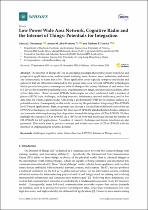 ResearchSpace
ResearchSpace
Low power wide area network, cognitive radio and the Internet of Things: Potentials for integration
JavaScript is disabled for your browser. Some features of this site may not work without it.
- ResearchSpace
- →
- Research Publications/Outputs
- →
- Journal Articles
- →
- View Item
| dc.contributor.author |
Onumanyi, Adeiza J

|
|
| dc.contributor.author |
Abu-Mahfouz, Adnan MI

|
|
| dc.contributor.author |
Hancke, GP

|
|
| dc.date.accessioned | 2021-01-17T16:10:18Z | |
| dc.date.available | 2021-01-17T16:10:18Z | |
| dc.date.issued | 2020-11 | |
| dc.identifier.citation | Onumanyi, A.J., Abu-Mahfouz, A.M.I. and Hancke, G.P. 2020. Low power wide area network, cognitive radio and the Internet of Things: Potentials for integration. Sensors, v20(33), 41pp. | en_US |
| dc.identifier.issn | 1424-8220 | |
| dc.identifier.uri | https://doi.org/10.3390/s20236837 | |
| dc.identifier.uri | https://www.mdpi.com/1424-8220/20/23/6837 | |
| dc.identifier.uri | http://hdl.handle.net/10204/11721 | |
| dc.description | Copyright: 2020 by the authors. Licensee MDPI, Basel, Switzerland. This article is an open access article distributed under the terms and conditions of the Creative Commons Attribution (CC BY) license (http://creativecommons.org/licenses/by/4.0/). | en_US |
| dc.description.abstract | The Internet of Things (IoT) is an emerging paradigm that enables many beneficial and prospective application areas, such as smart metering, smart homes, smart industries, and smart city architectures, to name but a few. These application areas typically comprise end nodes and gateways that are often interconnected by low power wide area network (LPWAN) technologies, which provide low power consumption rates to elongate the battery lifetimes of end nodes, low IoT device development/purchasing costs, long transmission range, and increased scalability, albeit at low data rates. However, most LPWAN technologies are often confronted with a number of physical (PHY) layer challenges, including increased interference, spectral inefficiency, and/or low data rates for which cognitive radio (CR), being a predominantly PHY layer solution, suffices as a potential solution. Consequently, in this article, we survey the potentials of integrating CR in LPWAN for IoT-based applications. First, we present and discuss a detailed list of different state-of-the-art LPWAN technologies; we summarize the most recent LPWAN standardization bodies, alliances, and consortia while emphasizing their disposition towards the integration of CR in LPWAN. We then highlight the concept of CR in LPWAN via a PHY-layer front-end model and discuss the benefits of CR-LPWAN for IoT applications. A number of research challenges and future directions are also presented. This article aims to provide a unique and holistic overview of CR in LPWAN with the intention of emphasizing its potential benefits. | en_US |
| dc.language.iso | en | en_US |
| dc.publisher | MDPI | en_US |
| dc.relation.ispartofseries | Worklist;24049 | |
| dc.subject | Cognitive radio | en_US |
| dc.subject | Future direction | en_US |
| dc.subject | Low Power Wide Area Network | en_US |
| dc.subject | LPWAN | en_US |
| dc.subject | Internet of Things | en_US |
| dc.subject | IoT | en_US |
| dc.title | Low power wide area network, cognitive radio and the Internet of Things: Potentials for integration | en_US |
| dc.type | Article | en_US |
| dc.identifier.apacitation | Onumanyi, A., Abu-Mahfouz, A. M., & Hancke, G. (2020). Low power wide area network, cognitive radio and the Internet of Things: Potentials for integration. http://hdl.handle.net/10204/11721 | en_ZA |
| dc.identifier.chicagocitation | Onumanyi, AJ, Adnan MI Abu-Mahfouz, and GP Hancke "Low power wide area network, cognitive radio and the Internet of Things: Potentials for integration." (2020) http://hdl.handle.net/10204/11721 | en_ZA |
| dc.identifier.vancouvercitation | Onumanyi A, Abu-Mahfouz AM, Hancke G. Low power wide area network, cognitive radio and the Internet of Things: Potentials for integration. 2020; http://hdl.handle.net/10204/11721. | en_ZA |
| dc.identifier.ris | TY - Article AU - Onumanyi, AJ AU - Abu-Mahfouz, Adnan MI AU - Hancke, GP AB - The Internet of Things (IoT) is an emerging paradigm that enables many beneficial and prospective application areas, such as smart metering, smart homes, smart industries, and smart city architectures, to name but a few. These application areas typically comprise end nodes and gateways that are often interconnected by low power wide area network (LPWAN) technologies, which provide low power consumption rates to elongate the battery lifetimes of end nodes, low IoT device development/purchasing costs, long transmission range, and increased scalability, albeit at low data rates. However, most LPWAN technologies are often confronted with a number of physical (PHY) layer challenges, including increased interference, spectral inefficiency, and/or low data rates for which cognitive radio (CR), being a predominantly PHY layer solution, suffices as a potential solution. Consequently, in this article, we survey the potentials of integrating CR in LPWAN for IoT-based applications. First, we present and discuss a detailed list of different state-of-the-art LPWAN technologies; we summarize the most recent LPWAN standardization bodies, alliances, and consortia while emphasizing their disposition towards the integration of CR in LPWAN. We then highlight the concept of CR in LPWAN via a PHY-layer front-end model and discuss the benefits of CR-LPWAN for IoT applications. A number of research challenges and future directions are also presented. This article aims to provide a unique and holistic overview of CR in LPWAN with the intention of emphasizing its potential benefits. DA - 2020-11 DB - ResearchSpace DP - CSIR KW - Cognitive radio KW - Future direction KW - Low Power Wide Area Network KW - LPWAN KW - Internet of Things KW - IoT LK - https://researchspace.csir.co.za PY - 2020 SM - 1424-8220 T1 - Low power wide area network, cognitive radio and the Internet of Things: Potentials for integration TI - Low power wide area network, cognitive radio and the Internet of Things: Potentials for integration UR - http://hdl.handle.net/10204/11721 ER - | en_ZA |





